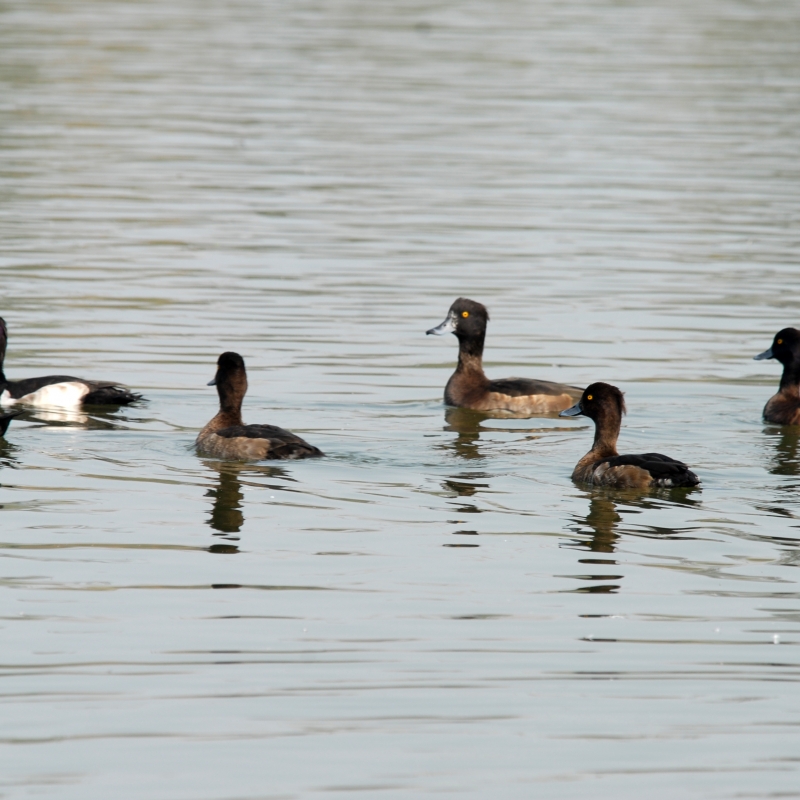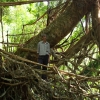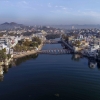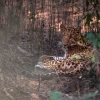A wetland is a unique ecosystem that forms a zone of transition between an aquatic and terrestrial ecosystem. It is considered to be the most productive amongst all the ecosystems (Ghermandi et al 2008). A wetland is mainly defined as an area that is saturated by surface or ground water for most parts of the year. Such saturated conditions give them the characteristic of having hydric soil, which is a characteristic feature of wetlands. Wetlands not only support great biodiversity but are also the source of livelihood for one out of every seven people on earth.
Wetlands are characterized by unique hydrological, soil (substrate) and biotic conditions. The hydrological regime, a resultant of the duration, flow, amount, and frequency of water on a site, is a major factor driving the other ecological features of a wetland. Since wetlands are transitional zones of terrestrial and aquatic ecosystems, they are zones of rich biodiversity, often inhabited by plants and animals of both wet and dry environments, thereby demonstrating a phenomenon called, the ‘edge effect.’ They provide a habitat to a great variety of invertebrate, fish, reptile, and amphibian species.
As mentioned earlier, the importance of wetlands increases manifold as they are directly linked to the livelihood of almost 15 per cent of the global human population. Ranging from fishing to rice cultivation, a wide range of activities are dependent on wetlands. It is estimated that these areas also attract 50 per cent of all international tourists. This is significant from the point of view of the travel industry which is responsible for around 200 million jobs globally. Similarly, about 40 per cent of all fish consumed world-wide is cultured in these wetland areas. Approximately 75 percent of all commercial marine fish species depend on estuaries, which in turn depend on their wetlands to maintain these productive ecosystems (Prasad et al 2002). Pisciculture and aquaculture provide livelihood to over 650 million people. Furthermore, every day, the fresh water supply to megacities such as Delhi is ensured by wetlands. The Delhi Water Board, is responsible for providing about 830-835 million gallons of water per day during summers alone[i]. Despite their importance, two out of every three wetlands have disappeared since the beginning of the twentieth century[ii]. This loss has had an adverse impact not just on biodiversity but also on livelihood.
The Centre for Environmental Management of Degraded Ecosystems (CEMDE), University of Delhi in collaboration with the Delhi Development Authority started working towards establishing the Yamuna Biodiversity Park (YBP) in 2002, keeping in mind the environmental health of the highly polluted and environmentally degraded capital city of Delhi caused by inexorable lopsided development. The YBP area is a restored site that was set up as an ex-situ conservation site and it is envisioned to achieve self-sustainability like an in-situ conservation site over the coming years. This vision cannot be realized without the presence of the three functionally active wetlands in the park.
The YBP phase I has two wetlands, located on an inactive flood plain while phase II has a larger wetland spread out over an area of approximately 100 acres in an active floodplain. In phase I, the narrow shallow wetland (approx 1.8 km), has been drenched in the form of a little river that stretches throughout the whole length of phase I. The other wetland called the deep wetland (approx 7 acres), is located along the north-western boundary of phase I. The wetland in phase II being located on the active flood plain receives flood water from the Yamuna River nearby. This is a deep wetland being developed along with a mosaic of marshes, swamps and grasslands.
These wetlands provide a habitat to numerous species of submerged, emergent and floating vegetation type plants. A few important examples may include, species of Vallisneria, Hydrilla, Potamogeton (Submerged), Salvinia and Azolla (floating – limnetic zone), Nymphaea (water lily) and Nelumbo (Lotus) (Floating – Littoral zone), Phragmites and Typha (emergent), and trees such as Tamarix. These plants are adapted to specific conditions of soil and water provided by wetland ecosystems.
The wetlands are home to about seventy species of water birds including waders, cranes-storks, ducks and divers. Big flocks of migratory birds make their way to these wetlands every winter in search of ideal habitats. Little and Indian Cormorants, Darters, Herons, Egrets and some ducks like Spot-Billed Duck and Common Moorhen reside in and around these wetlands throughout the year. The island mounds act as roosting and resting place for these birds. Great Cormorants, Common Pochard, Red-Crested Pochards, Large Crested Grebe, Tufted Pochard, Common Teal, Eurasian Wigeon, Northern Shovler, Northern Pintail, Comb Duck, Gadwalls, Grey Leg Goose, Ferruginous Pochard, Eurasian Coots and other migratory birds from Siberia, Europe, China, Ladakh and other colder regions which fly to tropical regions for food and shelter also make their way to these wetlands every winter. YBP is the only destination in and around Delhi, where the Red-Crested Pochard makes a winter home. This recuperation of natural habitat in the park is motivating many species to come back to areas that they had formerly inhabited but had not been sighted in for a long time. Darter, a near threatened species, legally protected under the schedule IV of the Indian Wildlife (Protection) Act, 1972 had historically been a breeding resident of Delhi but it was not until 2006 that it began breeding again in the region after a period of disappearance (Niangthianhoi and Khudsar, 2015). Similarly, other water birds such as the White-breasted waterhen, Purple Swamphen, Herons, Egrets and ducks, also breed in the YBP. This was made possible by the restoration of the Tamarix-Phragmites forest alongside the wetlands that is a characteristic of the Yamuna river basin. This forest grows only on hydric soils, thus being specifically associated with wetlands. The forest also provides a proper cover to these water birds for building nests. Similarly, many species, such as the Black Crowned Night Heron and Seiboldi’s Water Snake had not been seen in the once glorious Yamuna plain in the Delhi region for decades. The Black Crowned Night Heron builds its nests in dense Phragmites-Tamarix forests. Due to the loss of its habitat, this bird had migrated to nearby states. In 2013, after many years, thousands of these birds were seen nesting in phase I of the YBP park. Similarly, in phase II, the Seiboldi’s Water snake, a mildly venomous water snake, has been observed breeding successfully after nearly seventy five years of absence from the Delhi region. With the restoration of these critical ecosystems, many species that Delhi had supposedly lost, have started finding their way back into the megacity.
The desilting of wetlands in phase I of the park started in 2004. Phragmites, Tamarix and other emergent plants indicated the presence of a saturated ground water level and acted as indicator species that helped in identifying the location for digging. These wetlands were made ecologically functional by introducing plants such as Vallisneria, Hydrilla, Potemageton, Salvinia and Azolla. These species formed the primary level of the food chain. Fish such as Rohu, Mirgal and Catla were also introduced initially to sustain the newly established ecosystem. Salvinia and Azolla were the major plants that attracted herbivorous ducks initially. Cormorants and Darters followed the fish and fingerlings. Today, these wetlands are fully operational ecologically.
The work for dredging the wetland in YBP phase II started in the year 2011. More than five thousand ducks, divers and crane-storks can now be seen in the phase II area, every winter. This wetland, being located in the active flood plain, plays a major role in flood mitigation in the region. Furthermore, the area of the wetland where once only weeds such as Ecchornia grew, is now adorned with lotus blossoms.
The whole park has been designed in such a way that all the mounds have their slopes towards the wetlands. This helps in proper drainage and also assists in water harvesting. This design has also, through the years, helped in leaching of salts from the soil, therefore making the soil suitable enough for plants to grow.
From an ecological point of view, the YBP can be called an assemblage of plant species of the Yamuna river basin arranged into biological communities. Sightings of mammals such as Indian Hare, Porcupine, Civet, Wild Pig, snakes such as Indian Cobra, Wolf Snake, Krait with six other species, turtles, amphibians as well as many species of birds and fish, indicates that the park today has achieved threshold habitat health, assisted and in many cases promoted by the wetlands here.
Wetlands play a significant role in keeping a river alive by acting as a nursery for its organisms. When there is flooding the water from a river fills up these wetlands. Fish fingerlings, small insects and plants get carried away with the water and are deposited into these wetlands. Here, they get a chance to complete their life cycle away from predators and dominating competitors. Another flood then takes away grown up flora and fauna. Wetlands also help in cleaning a river by filtering out liquid and solid waste. These wetlands play an indispensable role in shaping the vegetation type and in turn the biological community structure. They also play a crucial role in modulating the local hydrology of the region. Besides providing water for various anthropogenic purposes, these wetlands control floodwater and recharge ground water. They also maintain river flow during lean season besides moderating the local weather patterns. Carbon sequestration is another valuable ecological service being provided by these wetlands as they act as important carbon sinks.
The river Yamuna has had a long geological history and never before has its ecological condition been as precarious as it is today. The stretch of Yamuna that runs through the Delhi region is ecologically dead. One major reason for this is the loss of wetlands owing to “development”. In a developing country like India, wetlands play a very important role in generating livelihood for many, however, the irony is that they are seen as wastelands and are diverted for other land uses including agriculture, construction and for dumping garbage. It is unfortunate that we have failed to recognize the great utility provided by wetlands and have lost them for short term developmental schemes. These natural resources are renewable but their rate of renewal is much slower than the rate with which they are being wasted and polluted. This fact makes these resources scarcer than we think they are. As we go forward, with declining availability, these fundamental resources will become more and more expensive and only a few people will be able to afford these— and when such fundamental resources become scarce, then we will truly have an unmanageable crisis on our hands.
References
Ghermandi, A., Van den Bergh, J.C., Brander, L.M., De Groot, H.L. and Nunes, P.A. 2008. The economic value of wetland conservation and creation: a meta-analysis.
Niangthianhoi, S.L. and Khudsar, F.A. 2015. 'The nesting success of the Oriental Darter Anhinga melanogaster (Aves: Suliformes: Anhingidae) in the Yamuna Biodiversity Park, New Delhi, India'. Journal of Threatened Taxa 7.14, pp. 8148–53.
Prasad, S.N., Ramachandra, T.V., Ahalya, N., Sengupta, T., Kumar, A., Tiwari, A.K., Vijayan, V.S. and Vijayan, L. 2002. 'Conservation of Wetlands of India: A review. Tropical Ecology 43.1, pp.173–86.
A wetland is a unique ecosystem that forms a zone of transition between an aquatic and terrestrial ecosystem. It is considered to be the most productive amongst all ecosystems (Ghermandi et al 2008). A wetland is mainly defined as an area that is saturated by surface or ground water for most parts of the year. Such saturated conditions give them the characteristic of having hydric soil, which is a characteristic feature of wetlands. Wetlands not only support great biodiversity but are also the source of livelihood for one out of every seven people on earth.
Wetlands are characterized by unique hydrological, soil (substrate) and biotic conditions. The hydrological regime, a resultant of the duration, flow, amount, and frequency of water on a site, is a major factor driving the other ecological features of a wetland. Since wetlands are transitional zones of terrestrial and aquatic ecosystems, they are zones of rich biodiversity, often inhabited by plants and animals of both wet and dry environments, thereby demonstrating a phenomenon called, the ‘edge effect.’ They provide a habitat to a great variety of invertebrate, fish, reptile, and amphibian species.
As mentioned earlier, the importance of wetlands increases manifold as they are directly linked to the livelihood of almost 15 per cent of the global human population. Ranging from fishing to rice cultivation, a wide range of activities are dependent on wetlands. It is estimated that these areas also attract 50 per cent of all international tourists. This is significant from the point of view of the travel industry which is responsible for around 200 million jobs globally. Similarly, about 40 per cent of all fish consumed world-wide is cultured in these wetland areas. Approximately 75 percent of all commercial marine fish species depend on estuaries, which in turn depend on their wetlands to maintain these productive ecosystems (Prasad et al 2002). Pisciculture and aquaculture provide livelihood to over 650 million people. Furthermore, every day, the fresh water supply to megacities such as Delhi is ensured by wetlands. The Delhi Water Board, is responsible for providing about 830-835 million gallons of water per day during summers alone.[1]
Despite their importance, two out of every three wetlands have disappeared since the beginning of the 20th century.[2] This loss has had an adverse impact not just on biodiversity but also on livelihood.
The Centre for Environmental Management of Degraded Ecosystems (CEMDE), University of Delhi, in collaboration with the Delhi Development Authority started working towards establishing the Yamuna Biodiversity Park (YBP) in 2002, keeping in mind the environmental health of the capital city of Delhi, which had become highly polluted and environmentally degraded owing to inexorable lopsided development. The YBP area is a restored site that was set up as an ex-situ conservation site, and it is envisioned as achieving self-sustainability like an in-situ conservation site in the course of the coming years. This vision cannot be realized without the presence of the three functionally active wetlands in the park.
The YBP Phase I has two wetlands, located on an inactive flood plain, while Phase II has a larger wetland spread out over an area of approximately 100 acres in an active floodplain. In Phase I, the narrow shallow wetland (approx 1.8 km), was drenched by a little river that runs throughout the whole length of Phase I. The other wetland called the deep wetland (approximately seven acres), is located along the north-western boundary of Phase I. The wetland in Phase II being located on the active flood plain receives flood water from the Yamuna river nearby. This is a deep wetland being developed along with a mosaic of marshes, swamps and grasslands.
These wetlands provide a habitat to numerous species of submerged, emergent and floating vegetation types of plants. A few important examples include species of Vallisneria, Hydrilla, Potamogeton (submerged), Salvinia and Azolla (floating limnetic zone), Nymphaea or water lily and Nelumbo or lotus (floating littoral zone), Phragmites and Typha (emergent), and trees such as Tamarix. These plants are adapted to specific conditions of soil and water provided by wetland ecosystems.
The wetlands are home to about 70 species of water birds, including waders, cranes-storks, ducks and divers. Big flocks of migratory birds make their way to these wetlands every winter in search of ideal habitats. Little and Indian Cormorants, darters, herons, egrets and some ducks like the Spot-Billed Duck and Common Moorhen reside in and around these wetlands throughout the year. The island mounds act as roosting and resting place for these birds. Great Cormorants, Common Pochards, Red-Crested Pochards, Large Crested Grebes, Tufted Pochards, Common Teals, Eurasian Wigeons, Northern Shovelers, Northern Pintails, Comb Ducks, Gadwalls, Grey Leg Geese, Ferruginous Pochards, Eurasian Coots and other migratory birds from Siberia, Europe, China, Ladakh and other colder regions which fly to tropical regions for food and shelter also make their way to these wetlands every winter. The YBP is the only destination in and around Delhi where the Red-Crested Pochard makes a winter home. This recuperation of natural habitat in the park is motivating many species to come back to areas that they had formerly inhabited but had not been sighted in for a long time. Darter, a near-threatened species, legally protected under the Schedule IV of the Indian Wildlife (Protection) Act, 1972 had historically been a breeding resident of Delhi but it was not until 2006 that it began breeding again in the region after a period of disappearance (Niangthianhoi and Khudsar 2015). Similarly, other water birds such as the White-breasted Waterhen, Purple Swamphen, herons, egrets and ducks also breed in the YBP. This was made possible by the restoration of the Tamarix-Phragmites forest alongside the wetlands that is a characteristic of the Yamuna river basin. This forest grows only on hydric soils, thus being specifically associated with wetlands. The forest also provides a proper cover to these water birds for building nests. Similarly, many species, such as the Black-crowned Night Heron and Seiboldi’s Water Snake had not been seen for decades in the once glorious Yamuna plain in the Delhi region. The Black-crowned Night Heron builds its nests in dense Phragmites-Tamarix forests. Due to the loss of its habitat, this bird had migrated to nearby states. In 2013, after many years, thousands of these birds were seen nesting in Phase I of the YBP. Similarly, in Phase II, the Seiboldi’s Watersnake, a mildly venomous water snake, has been observed breeding successfully after nearly 75 years of absence from the Delhi region. With the restoration of these critical ecosystems, many species that Delhi had supposedly lost have started finding their way back into the megacity.
The de-silting of wetlands in Phase I of the park started in 2004. Phragmites, Tamarix and other emergent plants indicated the presence of a saturated groundwater levels and acted as indicator species that helped to identify sites for digging. These wetlands were made ecologically functional by introducing plants such as Vallisneria, Hydrilla, Potemageton, Salvinia and Azolla. These species formed the primary level of the food chain. Fish such as Rohu, Mirgal and Catla were also introduced initially to sustain the newly established ecosystem. Salvinia and Azolla were the major plants that attracted herbivorous ducks initially. Cormorants and Darters followed the fish and fingerlings. Today, these wetlands are fully operational ecologically.
The work for dredging the wetland in YBP phase II started in 2011. More than 5000 ducks, divers and crane-storks can now be seen in the Phase II area every winter. This wetland, being located in the active flood plain, plays a major role in flood mitigation in the region. Furthermore, the area of the wetland, where once only weeds such as Ecchornia grew, is now adorned with lotus blossoms.
The whole park has been designed in such a way that all the mounds have their slopes towards the wetlands. This helps in proper drainage and also assists in water harvesting. This design has also, through the years, helped in leaching salts from the soil, therefore making the soil suitable for plants to grow.
From an ecological point of view, the YBP can be called an assemblage of plant species of the Yamuna river basin arranged into biological communities. Sightings of mammals such as the Indian Hare, Porcupine, Civet, Wild Pig, of snakes such as Indian Cobra, Wolf Snake, Krait with six other species, turtles, amphibians as well as many species of birds and fish, indicate that the park today has achieved threshold habitat health, assisted and in many cases promoted by the wetlands here.
Wetlands play a significant role in keeping a river alive by acting as a nursery for its organisms. When there is flooding the water from a river fills up these wetlands. Fish fingerlings, small insects and plants get carried away with the water and are deposited into these wetlands. Here, they get a chance to complete their life cycle away from predators and dominating competitors. Another flood then takes away grown-up flora and fauna. Wetlands also help in cleaning a river by filtering out liquid and solid waste. These wetlands play an indispensable role in shaping the vegetation type and in turn the biological community structure. They also play a crucial role in modulating the local hydrology of the region. Besides providing water for various anthropogenic purposes, these wetlands control floodwater and recharge ground water. They also maintain river flow during lean seasons besides moderating the local weather patterns. Carbon sequestration is another valuable ecological service being provided by these wetlands, as they act as important carbon sinks.
The river Yamuna has had a long geological history and never before has its ecological condition been as precarious as it is today. The stretch of Yamuna that runs through the Delhi region is ecologically dead. One major reason for this is the loss of wetlands owing to ‘development’. In a developing country like India, wetlands play a very important role in generating livelihood for many, however, the irony is that they are seen as wastelands and are diverted for other land uses including agriculture, construction and for dumping garbage. It is unfortunate that we have failed to recognize the great utility provided by wetlands and have lost them for short-term developmental schemes. These natural resources are renewable but their rate of renewal is much slower than the rate with which they are being wasted and polluted. This fact makes these resources scarcer than we think they are. As we go forward, with declining availability, these fundamental resources will become more and more expensive and only a few people will be able to afford these—and when such fundamental resources become scarce, then we will truly have an unmanageable crisis on our hands.
References
Ghermandi, A., J.C. Van den Bergh, L.M. Brander, H.L. De Groot, and P.A. Nunes. 2008. The economic value of wetland conservation and creation: a meta-analysis.
Niangthianhoi, S.L. and F.A. Khudsar. 2015. 'The nesting success of the Oriental Darter Anhinga melanogaster (Aves: Suliformes: Anhingidae) in the Yamuna Biodiversity Park, New Delhi, India'. Journal of Threatened Taxa 7.14, pp. 8148–53.
Prasad, S.N., T.V. Ramachandra, N. Ahalya, T. Sengupta, A. Kumar, A.K. Tiwari, V.S. Vijayan. and L. Vijayan. 2002. 'Conservation of Wetlands of India: A review. Tropical Ecology 43.1, pp.173–86.
[1] Website of Delhi Jal Board, at http://www.delhi.gov.in/wps/wcm/connect/doit_djb/DJB/Home/About+Us (viewed on January 19, 2016).
[2] Website on World Wetlands Day (viewed on January 19, 2016).











